Draped Bust Half Cents: An Easy Early Series for Collectors
Draped Bust half cents were minted from 1800 to 1808. These have received less attention than Draped Bust large cents and multiple silver denominations with a Draped Bust motif. A set of Draped Bust half cents could be a realistic objective for most collectors of 19th century U.S. coins.
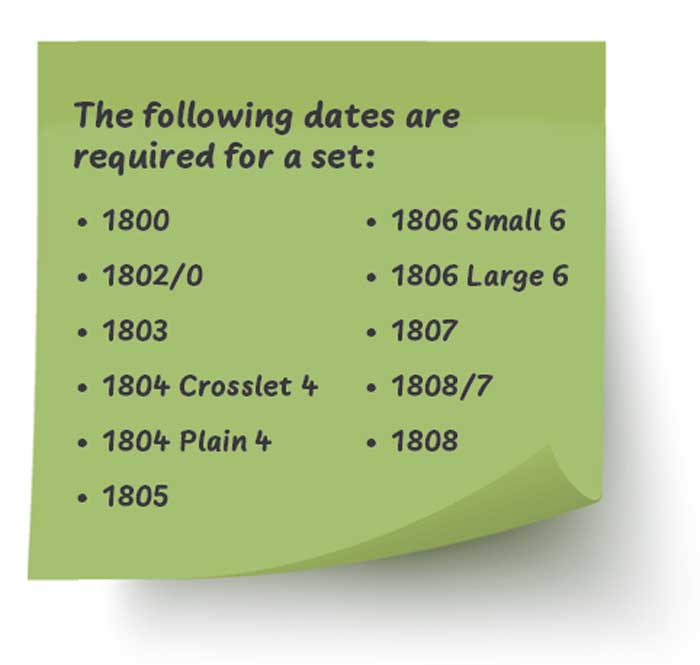
A starting checklist for early half cent collectors.
Draped Bust half cents were minted from 1800 to 1808. These have received less attention than Draped Bust large cents and multiple silver denominations with a Draped Bust motif. Yet, Draped Bust half cents are much more affordable than their sisters from the same, historically fascinating time period. A set of Draped Bust half cents could be a realistic objective for most collectors of 19th century U.S. coins.
While coins dating from 1793 to the 1830s are often referred to as ‘Early U.S. Coins,’ coins dating before 1808 or so have a special historical allure as the U.S. Mint was struggling. The nation as a whole was very young and growing into a role in the world. In 1800, the U.S. was a democracy that discomforted kingdoms abroad, a constitutional republic in a world where nations were governed by traditions. During the 1790s and very early 1800s, the U.S. was a free market capitalist society in a world where most societies were far from fully transitioning from feudalism.
Coins of the Spanish Empire dominated the circulating coinage in the U.S., though British Coppers tended to be the base coins of choice. Many copper tokens circulated as money as well.
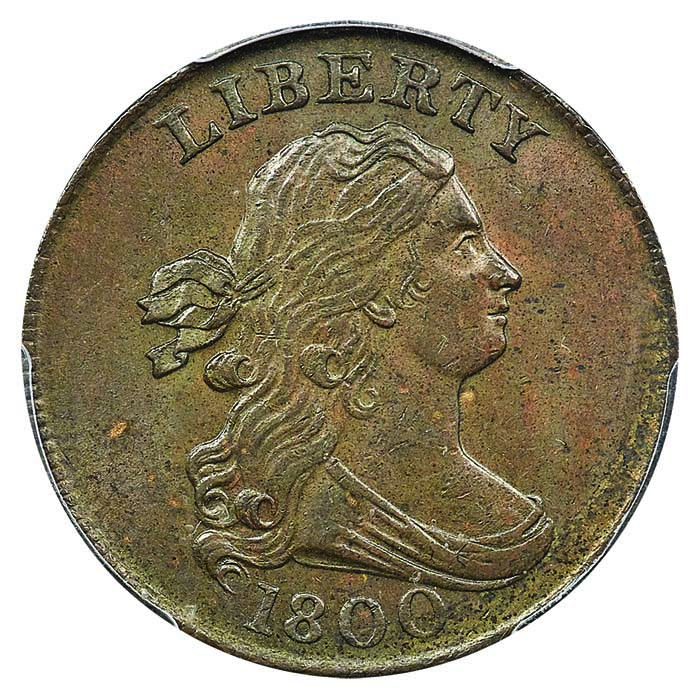
The obverse (front) side of an 1800 half cent.
Circa 1800, U.S. Mint-struck coins constituted a very small percentage of the coins in circulation in the country. Some notable politicians seriously considered shutting down the U.S. Mint. Draped Bust coins represent a fascinating era.
Because Draped Bust half cents are not extremely rare and are not currently all that popular, collectors may acquire them for non-large sums. Before even thinking about collecting die varieties, it makes sense to complete a set by date. Such a set would be understandable and meaningful to tens of thousands of coin collectors.
The collecting of die varieties is more complicated and of interest to a much smaller group. Most collectors will move on to another series after a completing a set by date. Some collectors, though, will become so enthralled with a particular series that they will feel compelled to add many additional varieties to their sets by date. This discussion is just about collecting by date as this undertaking is practical, not very expensive and not very difficult.
When collecting by date, there is not a need to distinguish stems from no stems. There are with stems and no stems varieties of 1804, 1805 and 1806 half cents. The wreath on the reverse (tail) consists of two parts, which are joined together at the bottom, above the (1/200) denomination, by a bow. On the With Stems reverse, each part of the wreath has a stem that sticks out near the bow. On the No Stems reverse, the two parts of the wreath lack stems and are thus not as long.
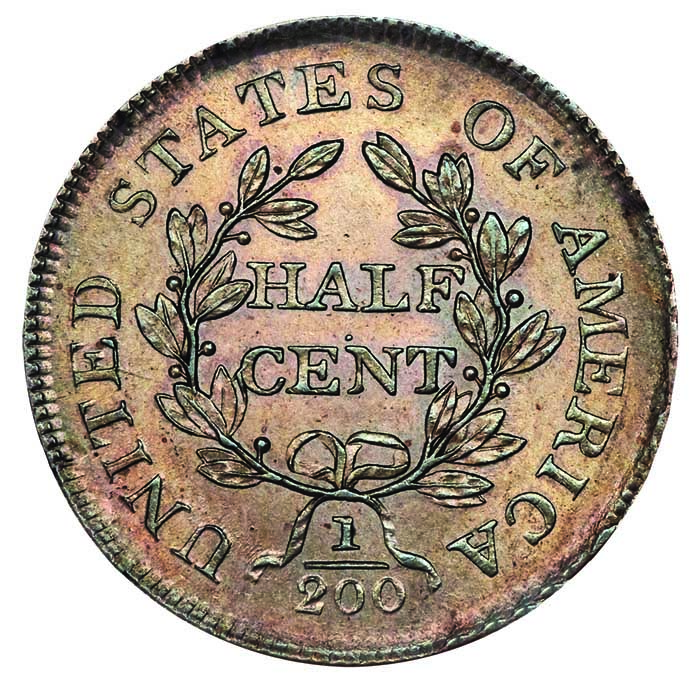
The reverse design of the draped bust half cent.
For a set that is intended to include all die pairings, or even all noticeable varieties, the stems are important. For a set by date, the presence or absence of stems does not matter. Collectors may focus upon the lower cost alternatives for each respective date.
Also, the 1804 Spiked Chin variety is a peculiar and accidentally ghoulish anomaly that is not really needed for a set. When dies are hit with metal objects, and depressions in the dies result, each coin minted will have raised metal corresponding to the respective locations where the dies were hit. Raised metal due to accidental or negligent hits may almost appear to be part of a design or provide a false impression that attracts attention. Varieties caused by unplanned indentations in the dies are usually not needed for sets by date.
The following dates are required for a set:
- 1800
- 1802/0
- 1803
- 1804 Crosslet 4
- 1804 Plain 4
- 1805
- 1806 Small 6
- 1806 Large 6
- 1807
- 1808/7
- 1808
While 1805 Small 5 and Large 5 varieties are minor, the 1806 Small 6 and Large 6 issues capture attention and should be collected as if they were two dates of the same year.
Generally, for an overdate to constitute a second date of the same year, the overdate must be readily apparent without magnification. The 1808/7 is an exception. While the 1808 over 7 overdate certainly exists, most survivors require a close inspection for the overdate to be discerned. It is pertinent, however, that the shape of the second eight of the “normal date” 1808 half cents is dramatically different from the second eight of the 1808/7 overdate half cents.
The second eight on the overdate is actually more normal than the second eight of the normal date 1808 half cents, which appears oddly high, bizarre and childish. The differences between the eight in the normal date 1808 half cents and the eight in 1808/7 are stark and entertaining. These differences capture the attention of collectors. It is logical to conclude that these are two different dates of the same year.
There is not need to analyze the 1802/0 overdate to realize that is a requirement for a set as all known 1802 half cents are 1802/0 overdates. It is believed that 1801 half cents were never minted.
The 1800 has a mystique as the first date of the series and the first date of the 19th century. They do not cost a fortune. An 1800 half cent might be suitable as a gift for a collector or potential collector. Indeed, an 1800 half cent may be an interesting conversation piece at a party or at a family gathering.
On March 29, the firm of David Lawrence sold a PCGS graded VG10 1800 for $200 even. On February 16, the Goldbergs auctioned a PCGS graded AU53 1800 half cent for $840.
In the same auction on February 16, in Los Angeles, the Goldbergs auctioned a raw 1802/0 that Bob Grellman graded as G5, for $690. At the FUN Convention in January 2020, Heritage auctioned a PCGS graded VG10 1802/0 for $1,980. In May 2019, Stack’s-Bowers sold a heavily corroded though very much discernible 1802/0, which was described as “Very Good, Heavy Porosity,” for $228.
A really nice 1802/0 half cent is very costly. On March 19, Stack’s-Bowers auctioned a CAC approved, PCGS graded VF30 1802/0 for $16,800. In March 2017, Stack’s-Bowers auctioned the Pogue Collection 1802/0, which was PCGS graded XF45. It realized a record price of $199,750.
It is easy to find an 1803. On February 18, 2020, Stack’s-Bowers sold a PCGS graded G6 1803 for $70. On February 16, the Goldbergs auctioned six 1803 half cents.
In the context of market levels for 1804 large cents, 1804 dimes and 1804 quarters, 1804 half cents are very inexpensive. On June 10, Stack’s-Bowers sold a PCGS graded F15 1804 Crosslet 4 for $132. On February 6, Heritage sold a PCGS graded AU50 1804 Crosslet 4 for $516. On March 15, this same firm sold a PCGS graded AU58 1804 Crosslet 4, with a sticker of approval from CAC, for $753.60. Late in April, Heritage sold an NGC certified MS64 Brown 1804 Crosslet 4 for $3,600.
For half cents in grades from AG3 to MS62 or so, the Greysheet and CDN CPG ® estimates indicate that market values for both the 1804 Plain 4 and the 1804 Crosslet 4, No Stems are almost the same as values for the 1805 Small 5, No Stems, the 1806 Small 6, No Stems, and the 1806 Large 6. In grades above MS63, prices vary considerably.
On February 16, the Goldbergs auctioned a raw 1805 that Grellman graded as F15+ for $180. On January 28, Heritage sold an NGC graded VF25 1805 for $222. On February 18, Stack’s-Bowers sold a PCGS graded XF45 1805 for $432.
On January 22, Heritage sold an NGC graded F12 1806 Small 6 half cent for $105. On March 1, DLRC sold a CAC approved, PCGS graded VF25 1806 Small 6 half cent for $250. On June 17, Heritage sold a PCGS graded XF40 1806 Small 6 half cent for $336. On February 23, Heritage auctioned an NGC graded MS62 1806 Small 6 half cent for $1,110.
On February 16, the Goldbergs auctioned a PCGS graded AU53 1806 Large 6 half cent for $552. The cataloguer, Bob Grellman, graded this coin as VF35.
In grades below VF25, the 1807 is one of the least scarce dates. In higher grades, though, 1807 half cents command a substantial premium over similar coins of the dates just mentioned. On February 16, the Goldbergs auctioned a PCGS graded AU55 1807 half cent for $1,380. The cataloguer, Bob Grellman, graded that 1807 as AU50.
The 1808/7 is extremely scarce, possibly rare. Many of the survivors have been found to be ungradable by PCGS and NGC, or would be so judged if submitted.
I figure that between 475 and 800 1808/7 half cents survive, most likely around 635, less than half of which merit numerical grades in my view. All but around 60 grade below VF20. The 1808/7 is an extreme rarity in grades from XF40 to mint state.
On January 29, Heritage sold a PCGS graded VG10 1808/7 for $288, which was more of a wholesale price than a retail price. On March 19, Stack’s-Bowers auctioned a PCGS graded AU53 1808/7 for $12,000, a strong price.
While hundreds of circulated 1808 half cents are around, the 1808 is especially rare in mint state grades. On January 5, 2020, the firm of David Lawrence sold a PCGS graded F12 1808 for $185. On February 16, the Goldbergs auctioned a PCGS graded VF35 1808, with a sticker of approval from CAC, for $504. On February 12, Heritage sold a PCGS graded XF40 1808 for $564. On March 19, Stack’s-Bowers auctioned a PCGS graded MS63 1808 for $9,000.
By the way, it is not implied that I agree with the PCGS or NGC certified grades of the coins cited in this article. It is a fact, not an opinion, that PCGS or NGC certification has a tremendous impact on the value of a classic U.S. coin that costs more than $250. Sale results are cited to provide general impressions of availability and market values; no individual coin is being recommended here.
Early copper coins tend to have notable imperfections, some of which are hard to explain. Most have been conserved or otherwise modified in one way or another. Collectors should start by spending amounts that the respective collector regards as small amounts of money. Collectors tend to learn about a series while a set is being assembled. Before spending an amount that the respective collector regards as a large amount of money, it is a good idea to consult experts and ask questions.
Each collector should focus on coins that he or she regards as good values. One collector may enjoy owning an AG3 grade coin more than another enjoys owning a MS62 grade coin.
It is important to learn about positive and negative aspects of individual coins, form realistic expectations and to enjoy the process of building a collection. Most interested collectors will find that completing a set by date of a series that dates from 1800 to 1808 is a very satisfying experience.
Copyright ©2020 Greg Reynolds
Insightful10@gmail.com
Images courtesy of Heritage Auctions.

Download the Greysheet app for access to pricing, news, events and your subscriptions.
Subscribe Now.

Subscribe to CPG® Coin & Currency Market Review for the industry's most respected pricing and to read more articles just like this.
Source: Greg Reynolds


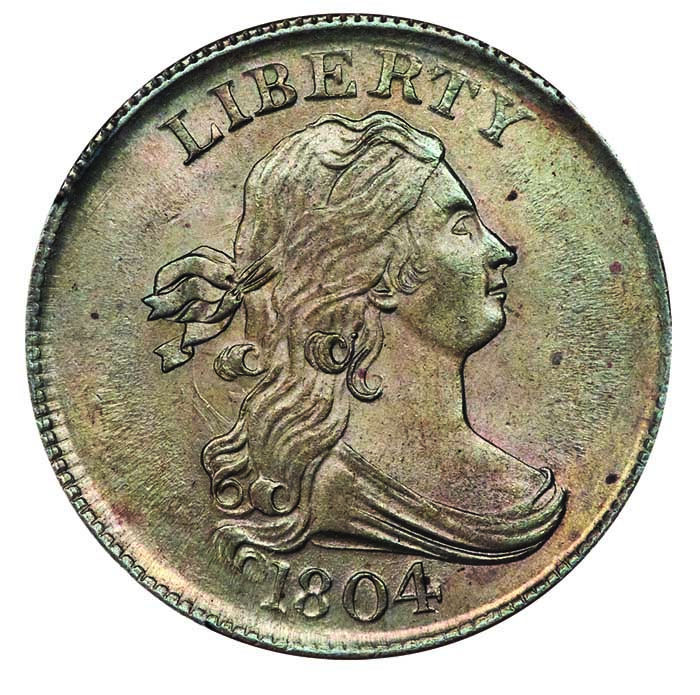






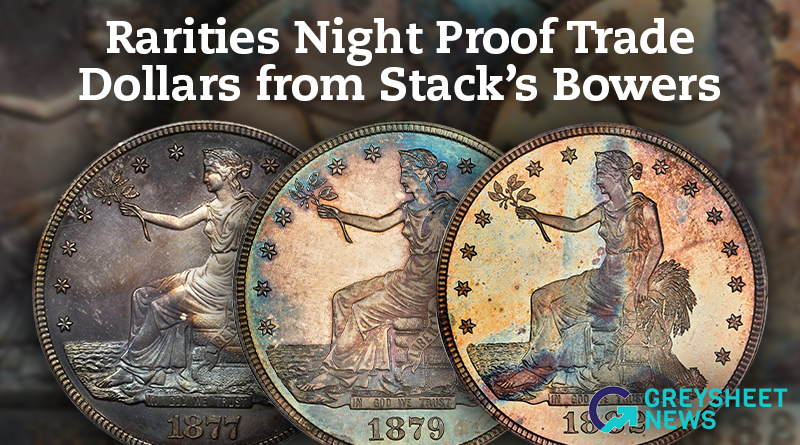
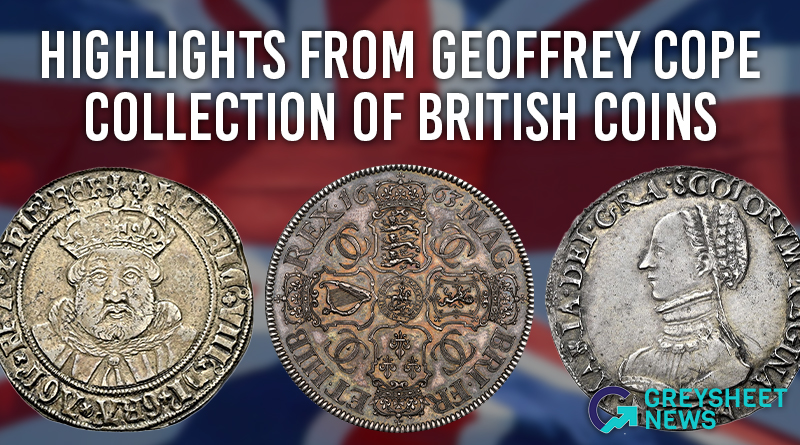
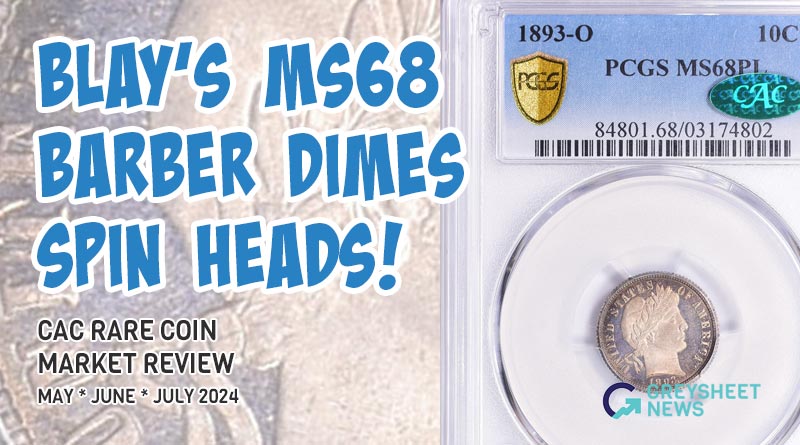
Please sign in or register to leave a comment.
Your identity will be restricted to first name/last initial, or a user ID you create.
Comment
Comments